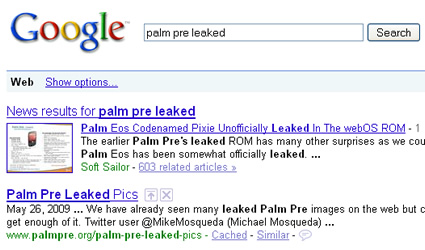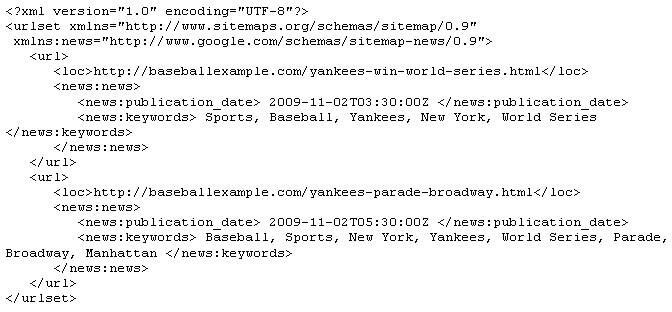
As Twitter and Facebook boom, the need for real-time search grows more important. When people want information about breaking news, they Google it. It’s their initial reaction… And if you’re not there, you might as well not exist (even if you have the greatest article on the web about the subject at hand.) So, when I’m analyzing websites that contain articles and posts that could be considered news, I’m obviously interested in seeing the amount of traffic coming from sites like Google News. After checking referring traffic levels, top content, and trending, I check to see if a Google News sitemap exists. I’ve always been a believer that if Google provides a way to send it structured data with additional information about your posts and articles, you should use it (period!) Unfortunately, many site owners don’t take the time to set up a Google News sitemap. I think it sounds harder to do than it really is, so they just brush it off. As you probably can guess, I think that’s a bad idea. :)
Google News Being More Than Google News…
When searching for a hot topic, some people head straight to Google News, however, many simply search on Google’s homepage or via their Google Toolbar. The way your listing shows up will vary depending on where the user searches. For example, thanks to Universal Search, news content is being mixed into the organic listings for targeted queries. For example, you might see a thumbnail and headline in a Google News one box at the top of the search results. See the screenshots below for a few examples.


I’ve found that news content ranking in the organic listings can be a powerful driver of highly targeted search traffic (for obvious reasons). By the way, having your listing show up in the SERPs (with associated thumbnail) substantially increases your chances of click-through. Check the latest Google heatmap study to see the effect of Universal Search on user behavior if you don’t believe me. :) It also provides a great opportunity to gain valuable readers and subscribers, since you might be viewed as an authority site by visitors (since you rank highly in Google News.) Don’t underestimate how powerful top rankings can be credibility-wise.
So, how do you make sure Google has the necessary information about your latest articles, posts, and content so you can have a chance of ranking in Google News (and as part of Universal Search)? One way is to provide a Google News sitemap. Let’s dig deeper.
What is a Google News Sitemap?
In a nutshell, a Google News sitemap is an xml feed that enables you to tell Google about your latest content, including information like publication date and news tags or keywords. In addition, as part of the keywords you provide, you can include Google News categories. You might already be familiar with xml sitemaps, or the xml feeds you provide Google and the other search engines that contain all the URL’s on your site. Google News sitemaps are similar, just tailored for news-related content. Note, Google requires that the information contained in the sitemap is less than three days old, so you wouldn’t want to provide a running list of URL’s in the feed. Instead, you would want to make sure your latest posts and stories are included. For example, if you provide the latest in electronics or search engine marketing or celebrity news, then a Google News sitemap containing your latest articles would be a smart feed to employ.
What Information Should You Provide In A Google News Sitemap?
You should create a Google News sitemap using the sitemap protocol (which is what you are probably using to create your standard xml sitemap). The core elements of a news sitemap include the namespace/URLset tag, your list of URL’s, publication date of each URL in W3C format, and optional news tags (which can include Google News categories). There’s no limit to the number of keywords you can provide, but Google recommends you keep them fewer than 12. Click here to see a full listing of all categories used by Google News.
A Quick Example of a Google News Sitemap:
Let’s say I ran a website covering the latest in baseball. To keep this example simple, here is what my Google News sitemap would look like if it contained two new articles: (Can you tell I’m optimistic about the Yankees this year?)
Click the image below to view a larger version:

Submitting Your Google News Sitemap
Once you create your Google News sitemap, you should submit it via Google Webmaster Tools. Note, webmaster tools was just updated (June 10, 2009), and now you can find the sitemaps tab by clicking the plus sign next to Site Configuration (the first listing in the left navigation). First, upload your sitemap to your website (in the root directory of your website). Then submit your sitemap via webmaster tools by entering its location in the text box once you click the sitemaps tab.

Including a Reference to Your Sitemap or Sitemap Index File in Robots.Txt
You would also want to include a reference to your sitemap in your robots.txt file. If you have more than one sitemap, then use a sitemap index file, which can contain references to up to 1000 sitemaps (although you will probably never come close to that number). In addition, each news sitemap should not contain more than 1000 URL’s. If your sitemap contains URL’s older than 3 days, they will be rejected. If you have more than 1000 URL’s for your news sitemap, break them into separate sitemap files.
Here is what you would enter in your robots.txt file on a new line. Note, you would either enter the location to the sitemap file itself or the sitemap index file, which would reference several sitemap files.
Sitemap: {sitemap_location}
Google Webmaster Tools and Error Messages
Be sure to monitor your news sitemap in Google Webmaster Tools to view any errors being encountered by Google. Google will notify you and provide the exact error message, which can be extremely helpful. There are a number of errors that can occur, such as date not found, date too old, empty article, etc. You can find a full list of Google News sitemap errors here.
Moving Forward With Your Google News Sitemap
Based on what I’ve explained above, my hope is that you are ready to create your own Google News sitemap. It’s relatively straight forward to create and submit and can help you notify Google of all the news-related content hitting your website(s). In addition, if you automate the creation of your Google News sitemap, then it can work for you without having to dedicate any additional resources to it… It’s one of the projects I often recommend knocking out before other, more time-consuming SEO projects. Good luck and stop back and let me know how it worked out for you. I’d love to hear your thoughts.
GG
